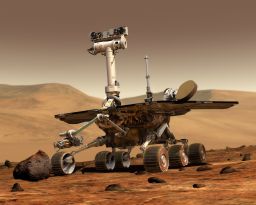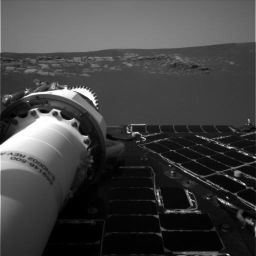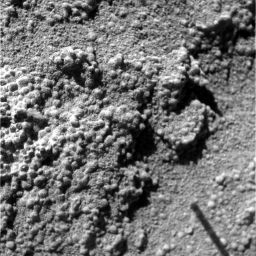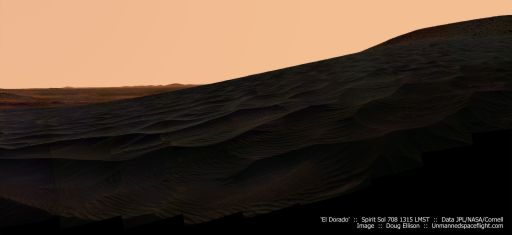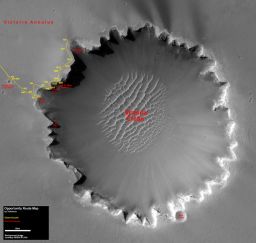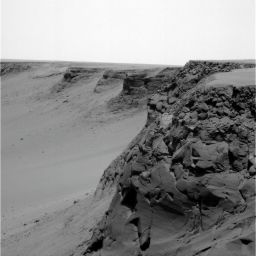A.J.S. Rayl • Dec 31, 2006
Mars Exploration Rovers Update: Spirit and Opportunity Smarten Up for Year 4 on Mars
Defying all the odds, the Mars Exploration Rovers (MERs) are wrapping up 2006 in new locations and roving into their fourth Earth year of exploring the Red Planet. Spirit is slated to celebrate the milestone on January 3, 2007 Pacific Daylight Time (PDT), with Opportunity marking the milestone just 3 weeks later, on January 24, 2007.
Spirit and Opportunity are each now more than 950 sols or Martian days past their "warranties" or primary missions of 90 sols, working nearly 12 times as long as originally planned. But these old rovers just keep roving and roving and in December they began learning more "new tricks," proving in a unique way that age can bring wisdom. With the fourth and most comprehensive of revisions to their flight software since launching in 2003, the twin robot field geologists now have the capability to take even more charge of their research as they begin Year 4 of their exploration of Mars.
During the last 3 years, the dynamic duo has raised the planetary rover bar higher than anyone ever anticipated. Spirit charted a course from its landing site in the grand Gusev crater through often treacherous terrain to Bonneville crater and then onto a distant set of hills named after the Columbia space shuttle crew that lost their lives in February 2003. Months before it got to the Columbia Hills in June 2004, however, the rover found evidence of past water that probably trickled underground, meeting the main science objective during the primary mission.
From the Columbia foothills, Spirit climbed Husband Hill, named for Columbia's commander Rick Husband, reaching the true summit on Sol 635 (October 15, 2005) to become the first rover to scale a hill on Mars. The rover then headed to the next hill in early 2006, named for Willie McCool, Columbia's pilot, with hopes of scaling its northern slopes for the coming Martian winter.
Of the two solar-powered MERs, Spirit has clearly had the rockier of journeys, and while the rover managed to rise to the challenges and overcome the obstacles again and again, conquering McCool Hill was not to be. A cantankerous right front wheel went out for good, transforming the rover into a five-wheeled vehicle, a configuration that made future mountaineering extremely tricky and potentially dangerous. With Martian winter coming, Spirit needed to get to a northerly slope where it could tilt its solar arrays toward the Sun to soak up as much of the light as possible.
Since Spirit is not as close to the equator as its twin, sunlight and the resulting power supply have been more serious issues for this rover. Following something of a mad dash, during which it encountered what appears to be an old eroded over volcano dubbed Home Plate, the rover on Sol 807 (April 10, 2006) settled into a parked position for winter at Low Ridge, not far from the base of McCool Hill. For 7 months, Spirit investigated this area of the Columbia Hills from that parked position at its winter haven, collecting atmospheric data that will inform scientists about the climate there as well as Mars' ever-changing weather, and investigating rocks and soil to determine the state and composition of the current local environment.
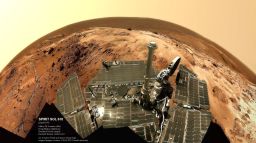 Spirit's view from Husband Hill on Sol 618
Spirit's view from Husband Hill on Sol 618An international team of four amateurs produced this panorama from Navcam images captured by Spirit from the summit of Husband Hill. An original grayscale mosaic was built by Marco Di Lorenzo, which was edited by Doug Ellison using bits from both right and left Navcam images to patch obvious image seams in the foreground. The resulting mosaic was artificially colored by Bernhard Braun, and was published on the cover of the Nov. 14, 2005 issue of Aviation Week and Space Technology. The panorama exemplifies the new opportunities that exist for amateurs to participate in space exploration because of the availability of the rovers' entire image catalogue on JPL's website.Credit: Aviation Week / M. Di Lorenzo, D. Ellison, B.Braun, and K. Kremer, from NASA / JPL images
This month, Spirit finally hit the road again, heading back to Home Plate. As it pulled out, the rover turned around to make some last minute observations of Low Ridge. It then drove a few meters to Esperanza, a lava rock pitted with holes that resembles a super-sized chunk of petrified Swiss-cheese, where it spent Christmas. Since "esperanza" is the Spanish word for "hope," it seemed a particularly fitting place to hunker down for the holidays. Beyond that, Esperanza was a "high-priority" target, Steve Squyres, of Cornell University, principal investigator for rover science, said during a recent interview. That's because vesicular lava rocks like this are "newly seen," according to Ray Arvidson, of Washington University, St. Louis, the deputy principal investigator for rover science, who noted: "There's a whole story that's coming together here."
On Sol 1061 (December 28, 2006), however, the dust in the atmosphere at the Columbia Hills site increased and Spirit's power levels dropped to 267 watt hours, the lowest ever on the mission. "If the dust were to be elevated for an extended period of time, it could be life-threatening to the rover," said John Callas, MER project manager at the Jet Propulsion Laboratory (JPL), mission control for the rovers. "The opacity of the atmosphere was up around .9 and the power was way down," Arvidson confirmed Friday, December 29. That essenially put the rover in the dark.
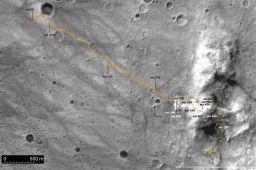 Spirit traverse map from Sol 1 to Sol 742
Spirit traverse map from Sol 1 to Sol 742This image shows the route that Spirit has driven inside Gusev Crater from Sol 1 to 742 (Jan. 2006 Feb. 2, 2006). The underlying image is a mosaic of images from the Mars Orbital Camera (MOC) on the Mars Global Surveyor orbiter. The scale bar at lower left is 500 meters (0.31 mile). As of Sol 742, the rover had driven a total of 6,430 meters (4.00 miles).Home Plate can be seen near the lower right hand corner. Credit: NASA / JPL-Caltech / MSSS / USGS / NMMNHS
With Spirit going into a 3-sol plan for New Year's and because the MER team had no way of knowing what was going to happen with the atmospheric opacity over the weekend, it decided to close out the experiment on Esperanza early and abort the weekend plan. "Instead, we did a drive that put us on a 7.4 degree tilt surface to the north," Arvidson said, and the rover's power rose back up to 285 watt hours, the level it was at for much of the winter at Low Ridge. "We feel a lot more comfortable now about the vehicle's survivability," Arvidson said. Spirit, which has driven about 6.9 kilometers (4.3 miles) and returned more than 88,500 images to date, is currently taking it easy, closing out 2006 by conducting atmospheric measurements and conserving energy.
For all its trials, tribulations, and accomplishments -- notably the discovery that water altered the mineral composition of some soils and rocks in the older hills above the plain where it landed and the first-ever picture of Mars' whirling dust devils from the ground -- Spirit has repeatedly been pushed out of the spotlight by its more glamorous "sister" on the other side of the planet. Indeed, Opportunity seems to have had more than its fair share of luck.
For starters, Opportunity had the good fortune of making the first "interplanetary hole-in-one," as Squyres described it, bouncing to a landing right inside Eagle crater in the Meridiani Plains. When it opened its "eyes," the rover was staring into the first bedrock seen on Mars, something that stunned bleary-eyed scientists and journalists at JPL in the wee hours of the morning after its memorable landing. The clues for past water were right there and in the final weeks of the 90-day primary mission, the MER team announced that Opportunity had sent home the gold -- evidence in minerals and rock textures that showed a large body of water, perhaps, a salty sea, drenched the surface there in the past.
After a thorough investigation of Eagle crater, Opportunity roved out onto the vast Meridiani plains that made for a Martian highway leading to some choice craters to the south. The rover broke record after record, driving more kilometers, examining more craters, including noteworthy stops at Endurance crater (Sols 94-317) and Erebus crater (Sols 590-760) crater, and going further back in Mars history than any other planetary rover. Throughout its journey, the rover analyzed numerous bedrock layers that recorded changing environmental conditions from the times when the layers were deposited and later modified, and found that wind blown dunes came and went and the water table fluctuated. It also checked out its own heat shield (Sols 325-330), another first for a Martian rover, and discovered a meteorite that bore a similar composition to a meteorite that landed on Earth from Mars long ago. From Erebus, Opportunity began the long journey to Victoria crater, the mother of craters in the area.
After a total of 21 months on the road, Opportunity pulled up to Victoria's rim on Sol 951 (September 26, 2006). The rover is currently cruising clockwise around the scalloped-shaped crater in a northeasterly direction, stopping at prominent overlooks or "alcoves," named for those Magellan visited on his voyage around the world from 1519 to 1522. The patterns in the layerings in Victoria's walls the rover has photographed "definitively speaks of this being dune deposits," Squyres pointed out.
From its entry point at Duck Bay, Opportunity has visited Cape Verde, Cape St. Mary, Bottomless Bay (Bahia sin Fondo), and is to "sail" into the next "alcove," dubbed the Bay of Toil on New Year's. "We're not messing around here," Squyres said just before Christmas, during a break in the "complicated process" of developing the 3-sol plans that put the rovers on "auto-pilot" for 3 day blocks of time to give the ground teams a break over the holidays. In the coming year, Opportunity, which has logged 9.8 kilometers (6.1 miles) and sent home some 80,7000 images so far, will likely go into Victoria at least part way to further expand the water story in Meridiani.
But there's more for Opportunity to see and do beyond Victoria and for Spirit beyond Home Plate in Gusev and the MER team will keep the rovers moving as long as they are able. "Since they have been operating well past the original 90-sol prime missions, there is always the possibility that a critical component on either rover could stop functioning at any time, so we value each additional day they continue to work," Callas said during an interview December 28.
For the MER team members, many of whom are now doing double or triple duty with other missions, the last 3 years have offered little time for reflection much less vacation, but as Spirit and Opportunity head into their fourth year of exploring Mars, they do seem to take every day just as seriously as the first. "We have 2 rovers on Mars and every day matters," offered Squyres with virtually the same enthusiasm he exhibited the days the rovers landed. Although such a statement could sound like so much official hyperbole, the level of sincere commitment is there.
From the rover's unparalleled achievements to the team's unending dedication, it's hard not to look back on the MER mission and marvel. "We have done everything we know that could be humanly done to ensure success . . . more testing and external reviews than for any previous interplanetary mission," said JPL Director Charles Elachi in the days leading up to Spirit's landing in 2004. The investment has paid off in ways no one could have possibly imagined then. While a human crew could probably accrue the same amount of science in a couple of weeks at each of the sites, the rovers' accomplishments truly are beyond all expectation. As Spirit and Opportunity forge onward, doing the work, sol in and sol out, they are setting the gold standard for planetary rovers, growing up to be inspirational emissaries for exploration and legends in their own time.
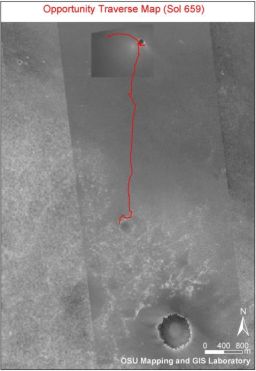 Opportunity traverse map Sols 1-659
Opportunity traverse map Sols 1-659This image shows the route Opportunity has driven from her first sol through Sol 659 (December 1, 2005), and the rover's next major destination, Victoria Crater, the large depression farther south. Color: Greyscale. Created: 28 December 2005.Credit: NASA / JPL-Caltech / MSSS / OSU
The twins' unexpected longevity is working out to everyone's -- and everything's -- advantage: Spirit and Opportunity get new "smarts" while designers and engineers at JPL and NASA get to test out new capabilities for future rover missions, including the Mars Science Laboratory, which is in development at JPL for launch in 2009. Since Thanksgiving time, Spirit and Opportunity have been testing their fourth upgrade of flight software. (They each received one flight software upgrade during the cruise to Mars and two upgrades since their January 2004 landings.) Based on software developed for NASA's Space Technology 6 "thinking spacecraft," the latest enhancements will allow the rovers to perform more of their field duties autonomously.
Spirit and Opportunity will be able to edit photographs before downlinking them to Earth, so there won't be any more cloud pictures without clouds, for example, or needless images of the same backgrounds for dust devil images that are transformed into little movies. With their new intelligence boosts, the rovers can recognize clouds or dust devils and select only the relevant parts of those images to send back home, freeing up more communication time for other scientific data.
The rovers will also now be able to think more than just one step ahead and navigate more effectively away from potential hazards in their paths, thus take longer solo drives across the Martian terrain. With another new feature, called "visual target tracking," Spirit and Opportunity will be able to continue to recognize a designated landscape feature or destination as they rove along.
While an earlier upgrade enabled the rovers to complete an experiment, stow an instrument, and head out to the next target -- a feature called "touch and go" -- the new "visual target tracking," when combined with another new feature, is giving them a capability to "go and touch." This enhancement will allow Spirit and Opportunity to calculate where and when it is safe to reach out and make contact with its scientific instruments, so that they can drive to a target and place a scientific instrument on it right after the drive without waiting for "approval" from their ground team on Earth.
Both Spirit and Opportunity passed their end-of-the-year physicals in "good health," reported Callas. "In fact, the biggest news about the health of the rovers is that it is essentially unchanged from 9 and a half months ago," he said. Despite a solar flare that knocked orbiter Mars Odyssey -- the relay communications link for most data received from the rovers -- into safe mode around, however ironically, December 7 (Pearl Harbor Day), the twin robot field geologists were otherwise unaffected and the MER mission ended 2006 with another highly productive month.
And the beat, as they say, goes on.
Spirit From Gusev Crater
Spirit began its journey from its winter haven of Low Ridge back to Home Plate this month, after completing an in-depth investigation of a rock target dubbed King George Island, research that took the latter part of November.
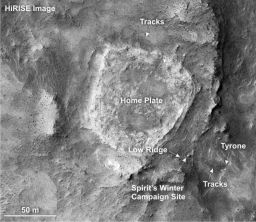 Spirit's current digs
Spirit's current digsThis image from the Mars Reconnaissance Orbiter's High Resolution Imaging Science Experiment (HiRISE)camera shows the area in the Inner Basin of the Columbia Hills that Spirit is currently roving around. Credit: NASA / JPL / Cornell
King George Island contains some of the "best-rounded grains ever seen in a Martian rock," as Squyres described them, and the rover examined it with microscopic imager (MI) pictures and the alpha-particle X-ray spectrometer (APXS) and the Mössbauer spectrometer to determine its composition. The rover then brushed the target with the wire bristles on the rock abrasion tool (RAT) to compare the surface below, collecting more APXS and Mössbauer spectrometer data for comparison with data from the unbrushed surface. The scientists will use this data to try to determine how the grains formed.
One possibility, Arvidson offered, is that these spherical little balls, each about 1 millimeter across, formed by accretion. "Imagine that you have a volcanic explosion with a lot of wet ash coming through the atmosphere. What can happen is that the ash tends to precipitate or agglomerate around particles, in basically the same way raindrops form." Theoretically, the ash particles in this location on Mars could have increased up to a millimeter in diameter, then gotten so heavy they fell out of the atmosphere and accumulated on the surface. "That's one possibility and it's consistent with everything we have seen so far," he said. "The rock that we got into by brushing away the soil from King George Island has a lot of hematite (Fe203), and also has other materials you find in basalt." That means, Arvidson continued, that it's likely "a volcanic, clastic deposit that's been cemented by something or other." Moreover, it's in an outcrop that's within a few tens of meters within Home Plate, which is "most likely is an eroded down explosive volcano," he added. "So it's all fitting together."
Spirit wrapped the month of November by taking MI pictures of soil targets known as Clarence and Deception, then opened December by analyzing a spot on the same rock surface but offset from King George Island. In the first days of December, the rover took MI pictures and collected corresponding compositional data for the APXS data of the target, as well as snapped a full-color panorama of the soil target known as Tyrone. (This patch of white soil is where the rover previously got stuck, but it offered up another sign of past water in its sulfate-rich content. Some of that white soil collected in the rover's wheels as it maneuvered itself out of Tyrone and apparently dropped out along the route to Low Ridge last April.)
After completing work at King George Island and analyzing the mineral content of nearby rock targets Korolev and Esperanza with the miniature thermal emission spectrometer (mini-TES), Spirit stowed the instrument deployment device (IDD), the robotic arm carrying scientific instruments, and on Sol 1037 (December 3, 2006) made the first of several drives to Esperanza, the site named for hope and the first planned stop on the way back to Home Plate. Despite low power and a non-functioning right front wheel, the rover completed short drives of 1 meter (3.3 feet) on Sol 1039 (December 5, 2006), and 1.5 meters (5 feet) toward the rock on Sol 1041 (December 7, 2006) with relative ease.
Throughout the month of December, Spirit continued to perform its daily atmospheric and remote sensing observations, checking atmospheric clarity by taking "tau" measurements with its panoramic camera (PanCam), readings from the sky and ground with its mini-TES instrument, and looking for clouds with the navigation camera. In addition to finishing up at King George Island and driving toward Esperanza during the first week of December, the rover tested some of its new flight software for the IDD, took some more images of the El Dorado dune field, sending home pictures of the beautiful, still waves that distinguish the Martian feature on Pearl Harbor Day, then surveyed the horizon with the PanCam, and once again scanned Esperanza with the mini-TES.
Following its drive on Sol 1041 (December 7, 2006), Spirit acquired more detailed images with its hazard avoidance camera and took a 360-degree view of its new surroundings with the navigation camera. Then, a burst of solar activity or solar flare apparently caused NASA's Mars Odyssey orbiter to go into a protective safe mode. Since only the systems essential to spacecraft health continue operating in this mode, Spirit was unable to relay any additional data to Earth for about a week, but the rover itself was unscathed. "A lot of the solar ions are absorbed by the atmosphere," explained Arvidson. "Most of the galactic cosmic rays get down to the surface, but we didn't see anything on Spirit or Opportunity," added the geology professor and chair of the Earth & Planetary Sciences department at St. Louis' Washington University. "It created havoc for Odyssey, but it didn't affect us at all," confirmed Squyres.
Since the MER team didn't have all of the needed information about Spirit's position after its Sol 1041 drive, the rover spent the next 8 Martian sols collecting untargeted remote sensing data along with the daily atmospheric observations. During this time, it turned back around, as previously planned, to snap some PanCam images for a full-color mosaic of Low Ridge, where it took refuge for the last Martian winter, then mini-TESed the area, snapped thumbnail images of the sky, and monitored the dust on its mast.
Meanwhile, back on Earth, Spirit's team turned some of its attention to going through the data accumulated during the nearly 7-month-long winter campaign. "Mars varies from year to year. It's a very active place in terms of the atmosphere and the atmosphere moving material around the surface," said Arvidson. "The winter campaign was partly about letting Mars come to us. As we look back on the winter campaign data, we saw water ice clouds maybe 10 to 15 kilometers high a number of times during this past winter; whereas, we didn't see any last year. So with this data we're getting at the weather and climate and how Mars varies from year to year."
The rover's repeated imaging of El Dorado, interestingly, showed the team that the waves didn't change. "But the color and the brightness of the surface changed as dust was blown off or accumulated onto it during the winter," Arvidson pointed out. "That shows Mars is a very active place in terms of the atmosphere."
Near the end of the second week in December, the Odyssey-MER links were reestablished and things returned to normal. Data transmission directly to Earth from Spirit on Sol 1046 (December 12, 2006) confirmed the rover was healthy and Odyssey recovered the following day, resuming that sol to relay data transmitted from the rover to the orbiter in the UHF radio band. Spirit finished up that second week of the month by continuing its photographic the survey of Low Ridge and studying it with the mini-TES.
On Sol 1049 (December 15, 2006) Spirit took some navigation camera images in support of mini-TES measurements of the rover's surroundings and took panoramic images of the area ahead. During the ensuing sols, the rover also began to scan for dust devils with the navigation camera. "We're starting to look for dust devils and we haven't seen any yet," Squyres said. "It's a little early. We expect to start seeing them about 6 to 8 weeks from now. But it makes sense to look so we've been checking."
When the rover turned to face Esperanza on Sol 1051 (December 17, 2006), it took images with its hazard avoidance cameras and then pulled out the PanCam to snap away for one of those a 360-degree panoramas. The rover also examined the local terrain and completed a survey of individual rock grains, known as clasts, then hunkered down for the holidays to really get into the intriguing lava rock pitted with holes. "These vesicular basaltic rocks are newly seen in the Inner Basin and kind of peripheral to Home Plate," Arvidson said. "They represent surface eruptions, probably with de-gassing of the magma to form the vesicles or bubbles, now holes in the rocks. The magma was volatile rich and once it reached the surface then the gasses quickly exolved and disappeared into the atmosphere." Spirit has been seeing rocks like Esperanza since last spring and the MER team has always wanted to inspect one. "But last April we parked for the winter and although we saw a number of these vesicular basalts, we couldn't drive to them," Arvidson reminded.
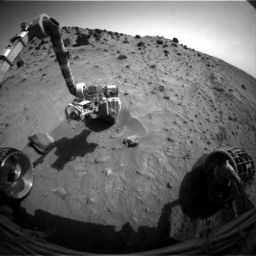 Arriving at Esperanza
Arriving at EsperanzaAfter nearly 7 months of investigating Low Ridge from a single parked position, Spirit hit the road again this month, beginning a short journey back to Home Plate, an intriguing circular feature that scientists believe is an eroded-over volcano. The rover made its first stop at a "high priority" target called Esperanza and took this image on Sol 1051 (Dec. 17, 2006) with is front hazard camera as it prepared to dig into this vesicular basaltic rock. Esperanza is pitted with holes and may have been magma ejected when Home Plate blew eons ago.Credit: NASA / JPL
With Martian winters lasting twice as long as those on Earth, the waiting became painful at times. Esperanza, therefore, was an obvious first target as winter receded. "It was a close accessible one; whereas, the other targets we saw like it on the other side of Low Ridge are too steep and the rocks too big and close together for navigating," Arvidson explained. "We couldn't really drive a lot in early December, because the Sun was still too low in the Martian sky, so the idea that we stop at Esperanza and knock off those measurements just seemed to be the right place, right time." (Spirit actually may have driven by some of these holey rocks right at the edge of the plains, but the team was so anxious to get to West Spur "we probably blew right past them," Arvidson said.)
In the week leading up to Christmas, Spirit tested some more new flight software sequences, including the first sequences of the "dust devil watch" enhancement that will help it distinguish the whirling clouds of dust in images with more ease. On Sol 1053 (December 19, 2006), the rover terminated a test run of a command sequence in the new flight software for autonomous placement of the rover's IDD. The sequence involved touching a target with the Mössbauer spectrometer, changing tools to the MI and suspending it 10 centimeters (4 inches) above the target, changing tools to the APXS, and placing it on the target. Spirit made preparations to re-run that test again on a new target and also run the full "dust devil watch" sequence on Sol 1058 (December 24, 2006 or Christmas Eve).
Spirit also spent time the third week in December taking MI pictures of a target at Esperanza dubbed Palma and analyzing the mineral content of a ground target known as Melchior. On Sol 1055 (December 21, 2006), the rover prepared to run another test with the APXS, followed by 6 hours of measurement with the instrument and also scanned other targets, including once called Druzhnaya with its mini-TES. During the sols that followed, the rover looked for the iron content of Palma using the Mössbauer spectrometer and the mineral content of a rock target now known as Gueslaga with the mini-TES and acquired PanCam and stereo images of a rock dubbed Orcadas. Then, during the Christmas holiday, Spirit got into Esperanza, taking the mission's "first really good look at vesicular basalt," noted Squyres. "We want to make sure that we get a really good Mössbauer integration and those take time now."
In fact, the Mössbauer integrations now take an average of 48 hours, as Arvidson pointed out in the last MER Update. The half-life for cobalt 57, the instrument's radioactive power source, is 270 days. "We lost 2 half-lives during transit, and we've now been on the surface a thousand days, so do the math -- we're way down," he elaborated recently. "That means what would typically take 4 hours during the primary mission now takes 48 hours."
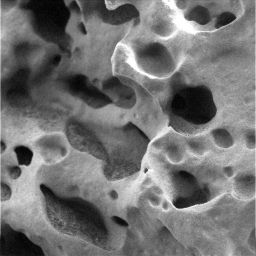 Esperanza up-close
Esperanza up-closeSpirit took this raw, close-up image of Esperanza, a vesicular basalt rock, with its microscopic imager (MI)on Sol 1053 (Dec. 19, 2006). The MER science team has seen a number of these rocks pitted with holes in the Inner Basin, but this is the first one to be examined in detail. It may have come from Home Plate, which science team members now believe is an eroded-over volcano. Credit: NASA / JPL
By Sol 1061 (December 27, 2006) Spirit was finishing up the APXS and Mössbauer spectrometer experiments on Esperanza, Arvidson reported that same day. The plan had been to continue those experiments through New Year's Day, then stow the IDD and head back to Home. The rover was not to retrace its tracks, however. "We're not going back to Tyrone, because we'll get stuck again," he said. Instead, Spirit would drive to an outcrop on the outer boundaries of Home Plate, called Troll (for a Norwegian base in Antarctica) and then head in from there. But the sudden increase in opacity or dust in the atmosphere around the Columbia Hills on Sol 1062 changed all that.
Spirit, like Opportunity, has benefited from minor cleaning events that come with little gusts of wind that whip around Mars from time to time, so its solar arrays were "neither real clean or really dirty," as Arvidson described them. But this rover is further enough south from the equator than its twin and in a dustier part of the planet. Those factors combine to makes a noticeable difference in terms of energy for a solar-powered rover. Spirit has struggled with power issues during the two 6-month long Martian winters its has survived, and on emerging this month from Low Ridge, it also lost "that nice 11-degree tilt toward the north" as it drove out of that winter haven on a relatively flat surface, Arvidson pointed out. It had already been dipping to levels below the desired low of 300 watt hours. Then, on Sol 1062 (December 28, 2006), "the opacity spiked up reducing power levels to 267 watt hours, the lowest power ever," Callas said in an interview later that day or sol.
"There is concern now that if the atmospheric opacity continues to deteriorate as Mars enters dust storm season, which is a period of unstable atmospheric opacity, it could be life-threatening for Spirit," Callas said. "Right now, we're being cautious," he added, confirming that the MER team took the necessary measures Thursday (December 28, 2006), commanding the rover to leave Esperanza and move about 4 meters to its current location so it could get a good "northerly tilt" and gain some extra margin in terms of solar energy.
Although a dust storm was whipping up to the south of Spirit yestersol (December 29, 2006), it didn't seem to be posing any additional threat and with the rover's power level back up to 285 watt hours, the team leaders were cautiously optimistic that the rover's energy will improve in coming sols. "Although we will not be sending up any more commands over the weekend, we will be watching the levels and we'll reevaluate things Tuesday [January 2, 2007]," said Arvidson. After that, provided everything goes well, Spirit will continue its journey to Troll, and following that will turn and head northwest to slide into Home Plate.
If Home Plate is an eroded-over volcano, which it probably is, it is of great scientific value, another big score for the winning team one might say. So it's not surprisingly that the plan to return has been on the table since the rover had to blow by it 10 months ago. On that first visit to the alluring circular feature, Spirit was only able to check out the northeastern sector, because it was in that mad dash to get to the northerly slope at Low Ridge for Martian winter.
"We did measurements on the east and northeast sides of Home Plate and found that the strata are cross-bedded and in some cases very coarsely layered," said Arvidson. "They tend to fit into the interior of Home Plate, like an explosion would." The scientists want to finish the measurements on the rest of Home Plate and are considering a circumnavigation of Home Plate, which is about 90 meters across, equivalent to what Opportunity is doing at Victoria, he said. "There is a whole story that's coming together here."
Opportunity from Meridiani Planum
With 3 alcoves under its rocker bogeys since beginning its circumnavigation of Victoria crater -- Duck Bay, Cape Verde, Cape St. Mary -- Opportunity roved on to the Bottomless Bay (Bahia sin Fondo) and into December with a 2-hour drive on Sol 1016 (December 2, 2006). It logged 30 meters (98 feet) that sol and pushed its odometer to 9,584.69 meters (6 miles), setting yet another rover driving record. Six miles would get most of us to the grocery store and back and it's a whole lot further than the football field's worth of real estate covered by Pathfinder's Sojourner rover, the MERs' predecessor, and way more than the 10 football fields the MERs had been designed to cover.
At Bottomless Bay, the rover spent the first week of the month taking a pretty standard navigation camera mosaic in the drive direction and worked on another sequence for the new flight software for the IDD, the new asset that will allow the rover to drive to a target, position the IDD and place a specific instrument right on the target without having to get "approval" from Earth. Like its twin, Opportunity continued with its daily atmospheric observations, checking clarity by taking "tau" measurements with its PanCam, and using its mini-TES instrument to take readings from the sky and ground, and the navigation camera to look for clouds.
Once it finished those daily science observations on Sol 1017, Opportunity took the rest of the sol to recharge from the long drive. The following sol, it got back to work, examining the ground in front of it with the PanCam and the mini-TES, which is also used to monitor the dust accumulation on its solar panels. It also used its APXS on Sol 1018 (December 4, 2006) to take a 2.5-hour argon density measurement. While pointed at the atmosphere, the instrument was turned on and left integrating for almost 3 hours. Measurements like this give scientists a better understanding of how atmospheric gases mix between the poles and the equator on Mars. With the temperature and argon density in hand, scientists can actually calculate what percentage of the atmosphere at the rover site is argon.
From Sol 1019 (December 5, 2006) to Sol 1021 (Dec. 7, 2006), Opportunity was busy completing its photography of Bottomless Bay, using the PanCam to take images for a stereo mosaic, some of which Squyres presented at the American Geophysical Union (AGU) meeting in San Francisco earlier this month. Though not quite as "sexy" as the ones taken of Cape Verde, by Squyres' reckoning, they still show the layerings that draw in geologists.
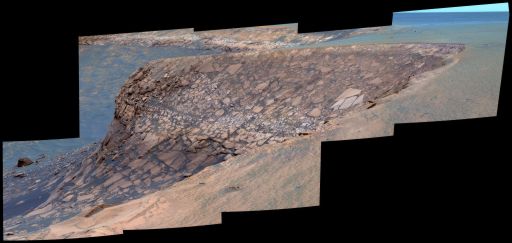 Cape Verde
Cape VerdeAs part of its investigation of Victoria crater, Opportunity examined a promontory called Cape Verde from the vantage point of Cape St. Mary, the next promontory clockwise around the crater's deeply scalloped rim. This view of Cape Verde combines several exposures, which the rover took with the panoramic camera on Sol 1006 (Nov. 22, 2006) during late-morning lighting conditions, into a false-color mosaic. The false color enhances subtle color differences among materials in the rocks and soils of the scene. The upper portion of the crater wall contains a jumble of material tossed outward by the impact that excavated the crater. This vertical cross-section through the blanket of ejected material surrounding the crater was exposed by erosion that expanded the crater outward from its original diameter, according to scientists' interpretation of the observations. Below the jumbled material in the upper part of the wall are layers that survive relatively intact from before the crater-causing impact.Credit: NASA / JPL-Caltech / Cornell
When the solar flare knocked the rovers' main communication link, orbiter Mars Odyssey, into safe mode, Opportunity rover handlers responded to the temporary unavailability of the orbiter by lightening the rover's task load. They commanded it to conduct the daily science observations then take a recharging nap the next sol, and for the ensuing week kept its scientific tasks in check for the rest of the orbiter's downtime to insure there wouldn't be a problem with the rover getting overloaded with data, like Spirit had way back in the beginning. That gave the everyone some of the worst nights experienced on the mission and it hasn't happened since. "When Odyssey was down, we really cut back on our data acquisition so we didn't build up a huge backlog and we went through it pretty well," Squyres said. "The Flash [memory] situation on Opportunity right now is the best it's been in many weeks."
Essentially, the team planned only a few drives and limited remote sensing activities until the orbiter returned to normal relay mode on Opportunity's Sol 1026 (December 12, 2006). Even so, between Sols 1021 (December 7, 2006) and 1027 (December 13, 2006), Opportunity drove 84 meters (276 feet). "We did get some significant driving done" [during Odyssey's downtime], said Squyres. "We did not plan drives in the blind, only where we had data." There was one very long drive already planned when Odyssey went into safe mode, but the MER team had all the images needed to plan it. "So what the heck," shrugged Squyres. "We were pretty restrained though with the PanCams. We'd see one of these big cliff faces, but we could generally knock it off with generally 5, 6, 7, 8 PanCam frames. We haven't been taking huge panoramas lately, but pretty modest panoramas where we focus in real tight on the stuff we really need."
With Odyssey back online, Opportunity employed the PanCam for the second half of the stereo mosaic of Bottomless Bay. At the same time, as the second week of the month got underway, the rover also took backward and forward-looking pictures with the PanCam, monitored the rover mast for dust, took pictures with the navigation camera to accompany mineral surveys from the mini-TES. It also measured atmospheric density of argon gas with the APXS, acquired panoramic camera images of the work volume it was going to examine, and surveyed the horizon with the mini-TES
In mid-December, Opportunity put the pedal to the metal again, driving 30 meters (98 feet) on Sol 1027 (December 13, 2006), and on the following sol, another 40 meters (131 feet). The rover logged 41 more meters (135 feet) between Sols 1029 (December 16, 2006) and 1034 (December 21, 2006), acquiring rearward-looking and forward-looking images of surrounding terrain using the navigation camera after each drive. As it drove, the rover snapped more pictures of Victoria's interior cliffs, capturing the assigned PanCam images looking southwest at Bottomless Bay, and imaged other points of scientific interest named Malua, Timor, and Cebu, as well as tested more sequences from its new flight software.
During the sols leading up to Christmas, Opportunity was preparing to examine a rock target known as Rio de Janeiro, and was even to use its rock abrasion tool (RAT) to brush the surface of and acquire post-brush MI pictures of the dust-free surface. The Sol 1036 (December 23, 2006) plans called for Opportunity to take a full-color mosaic of Rio de Janeiro using the PanCam and to study the outcrop with the Mössbauer spectrometer and to stay there for Christmas. "The reason we chose that name for the rock target is because Rio de Janeiro is where Magellan and his crew spent their first Christmas," informed Squyres. "They were heading south and spent Christmas at Rio de Janeiro."
While Earthlings prepared for the December holidays, Opportunity worked away, conducting the daily atmospheric observations and using the mini-TES to scan points of scientific interest known as Catalonia, Valencia, Andalucia, Aragon, Asturia, Cantabria, and Basque while at Rio. On Sol 1037 (December 24, 2006 or Christmas Eve), the rover took a series of images for a full-color mosaic of Bottomless Bay with the PanCam and checked out more scientific targets nicknamed Murcia, Navarra, Catalonia, and Valencia with the mini-TES.
With that work finished, Opportunity heads to the next location, "directly east from its location to the edge of the next major alcove," clockwise from Bottomless Bay, Squyres said. "We'll be imaging the promontory directly across from there, which is very sharp, very pronounced promontory that we've named Cape Desire. We're hoping by New Year's we'll be over at that next alcove, which we've called the Bay of Toil."
So far, Victoria isn't presenting the MER team with any confounding surprises. "It appears to be sulfate-rich all the way down," said Squyres. "Even though [the crater] goes quite deep, we haven't seen any indication that there's a change into some different material further down. That speaks to the stack of sulfates here being quite thick," he said.
The other thing they've seen in the wall of Victoria's cliff, particularly at Cape St. Mary, as it was viewed from Cape Verde, is "spectacular high-angle, aeolian cross-bedding," as Squyres described it. "That definitively speaks of this being dune deposits." Aeolian crossbedding, Compared with cross-bedding of subaqueous origin, is produced by wind action, generally forms sets that are much thicker, which dip at higher angles. It is thus characterized by heights of several meters and angles of dip greater than 30 degrees. "That's what we saw deep in Endurance crater too, so it was not a surprise at all," Squyres said.
For the immediate future, the rover will continue traversing Victoria's rim collecting images of the cliff walls, but the rover team is still scrutinizing the data from Bottomless Bay to see if it is a suitable future entry point into Victoria crater. No decision has been made yet, Squyres said, again. But with a crater that big -- on Mars, it would be hard to resist. But it may be amatter of first things first. There is that matter of another driving record.
As of Sol 1034 (December 21, 2006), Opportunity's total odometry was 9,758 meters (6.1 miles). "We're getting close to 10 kilometers in total odometry," noted Squyres. "We have about 250 meters to go, so if the rover keeps going, we'll crack 10-K with this thing soon."
Happy New Year to Spirit and Opportunity and all the people who make them fly.
For all the MER Updates, go to: http://www.planetary.org/explore/space-topics/space-missions/mer-updates/
Support our core enterprises
Your support powers our mission to explore worlds, find life, and defend Earth. You make all the difference when you make a gift. Give today!
Donate

 Explore Worlds
Explore Worlds Find Life
Find Life Defend Earth
Defend Earth


